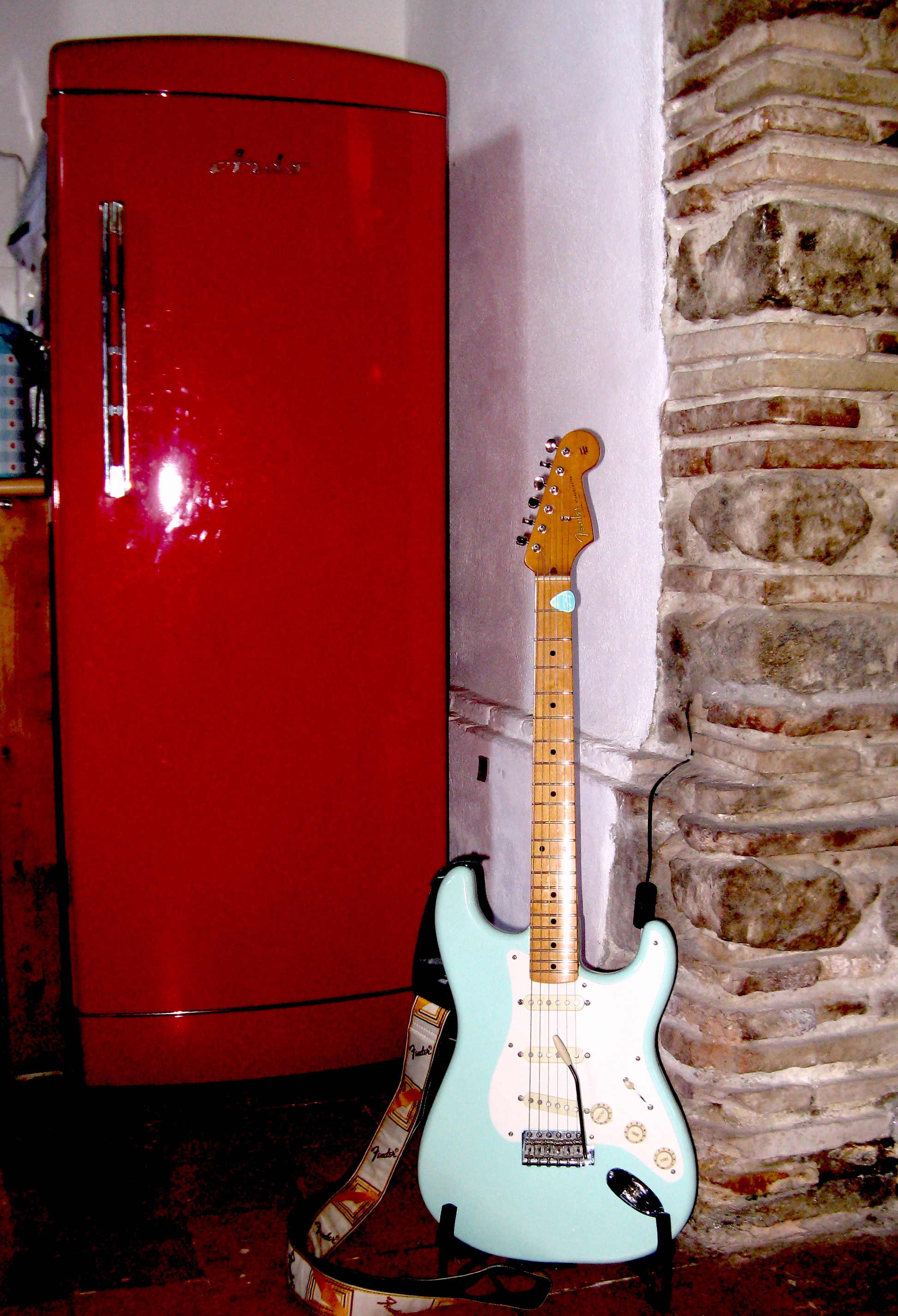 Fender has just released their new vintage-specific, made in Mexico, affordable Stratocasters, Telecasters, Mustangs and basses. Like the Classic Series they replace, they are made nearly like they used to do in the old days in California, namely the 1950s, the 60s, and the 70s. There are a plethora of videos on YouTube about this new MIM series and one of the most prominent stars is the Surf Green 50s – just like the one I own. After three years of playing it and fiddling with it a little bit, I came to understand and love my Classic 50s Strat. I am confident it is not a lesser guitar than the new Vintera and the changes that have been made are surely easily implemented on my specimen, too. Actually, the only think that really bothers me is my Strat not staying in tune after bendings. But I’m working on it…
Fender has just released their new vintage-specific, made in Mexico, affordable Stratocasters, Telecasters, Mustangs and basses. Like the Classic Series they replace, they are made nearly like they used to do in the old days in California, namely the 1950s, the 60s, and the 70s. There are a plethora of videos on YouTube about this new MIM series and one of the most prominent stars is the Surf Green 50s – just like the one I own. After three years of playing it and fiddling with it a little bit, I came to understand and love my Classic 50s Strat. I am confident it is not a lesser guitar than the new Vintera and the changes that have been made are surely easily implemented on my specimen, too. Actually, the only think that really bothers me is my Strat not staying in tune after bendings. But I’m working on it…
In late 2016, after I resumed playing guitar in a cover band, I decided to realize my teenage dream and buy a Stratocaster. I surfed the Internet and joined forums looking for information: I had stopped actually playing the electric guitar many years before and I knew absolutely nothing about Strat models and their characteristics, let alone what the market offered. My only constraints were that my Stratocaster should have been a real one, meaning a real Fender product, possibly made in USA. But the only reason for this was how strongly I had dreamed of having a Stratocaster when I was young; that’s why I felt that my first one should have been an actual Fender-branded Stratocaster. Very good copies are a great choice, even if assembled with high-quality parts. But I wanted the real thing, at least as my first model. American made meant that I should have spent more. And that was a problem. So, after a while a realized that some Mexican models were actually good bargains.
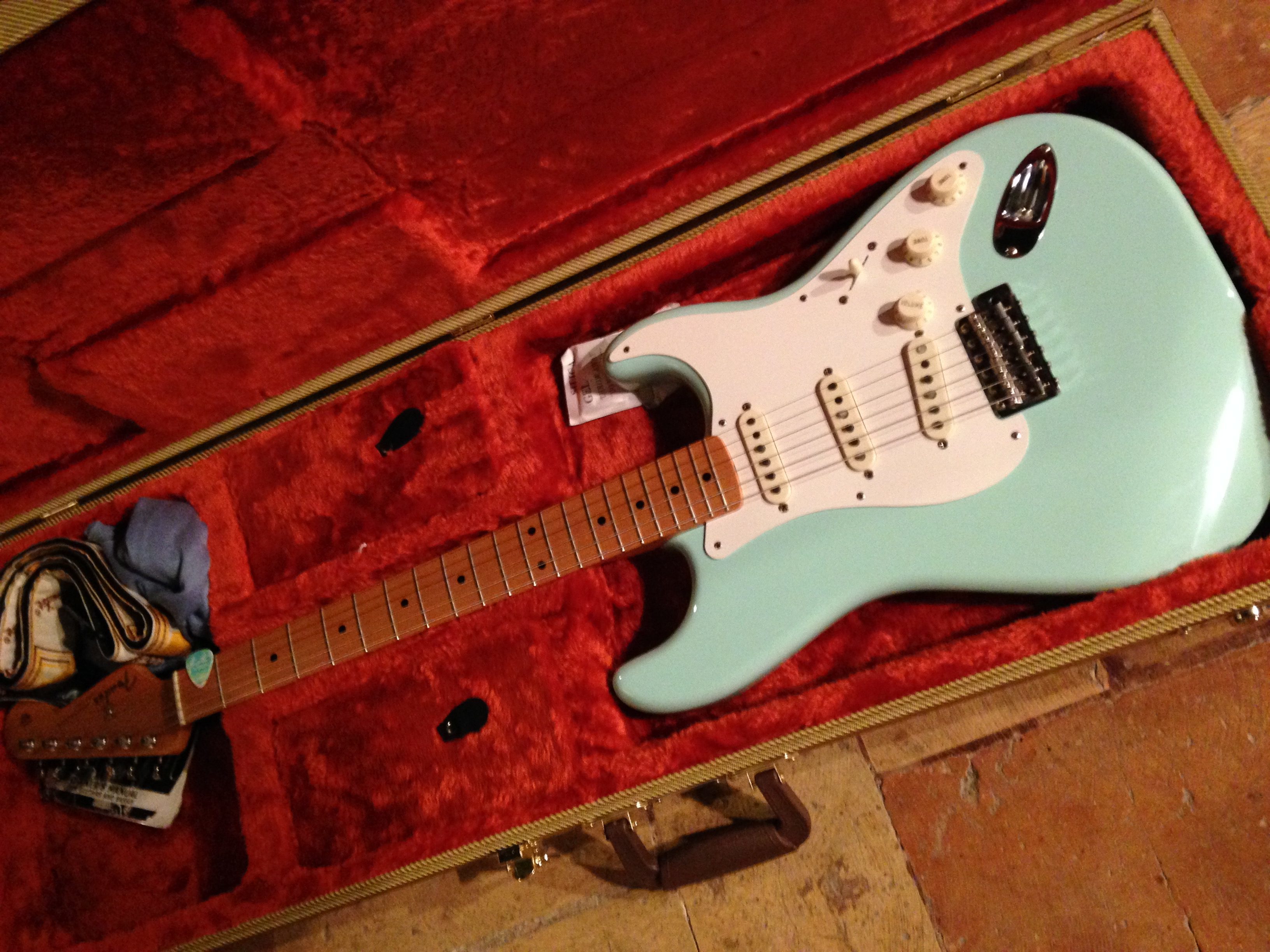 When I saw the ad of a used Surf Green Classic 50s Stratocaster at an inviting price, I just went for it. Many hate that color. I kind of love it. If I could have picked one, I’d have probably gone for the surf green. It came with the usual (and very comfortable!) gig bag. I felt it deserved a flight case, so I spent some extra money for a tweed case like those of the old times. It looks damn good in it!
When I saw the ad of a used Surf Green Classic 50s Stratocaster at an inviting price, I just went for it. Many hate that color. I kind of love it. If I could have picked one, I’d have probably gone for the surf green. It came with the usual (and very comfortable!) gig bag. I felt it deserved a flight case, so I spent some extra money for a tweed case like those of the old times. It looks damn good in it!
Made in Mexico? So what? Didn’t many Mexicans work for Fender in the 50s, assembling Strats that have immense value today? Someone told me that Fender Mexico is using the old machinery that was in California before, so the MIM Strats of today are made by Mexicans as in the old days, with the same machinery they used in California at the time! Rumor has it that Fender ships the wood parts to Mexico after having cut them in California. Today a computer program cuts the wood, so it is the same wherever it happens. If you want a manually cut body or neck you should ask a luthier to build one for you (and maybe one day I will). So how is my 2006 Classic Series 50s after 3 years of playing and some modding?
First of all, I must say that the maple soft-V shaped neck with vintage frets is incredibly good! I had bought the guitar from a luthier shop in Rome and he had done all the fine tunings and adjustments, fret job included. Players far better than me spent good words on both that neck and the pickups sound. The fretboard radius is a vintage 7.25 inches. They say it is harder to bend strings but well…. I didn’t notice any issue… I had read about people that upgraded the pickups with more expensive ones, only to come back to the stock ones after a while. Some went to the extent of claiming their own Classic Series outperformed even their American Vintage models!
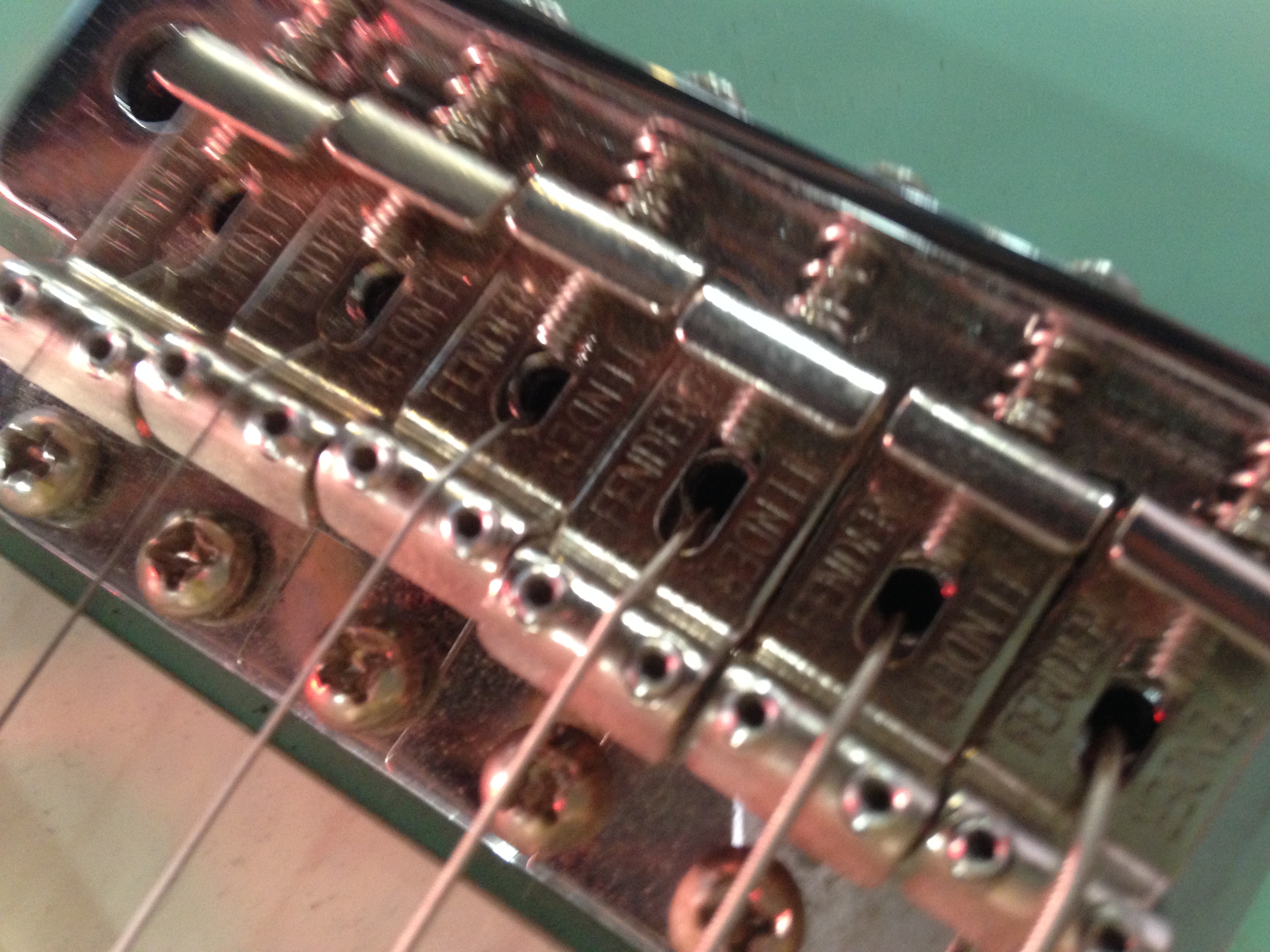 The only real quality issue I seemed to experience were the bridge saddles. The first time I tried to adjust intonation after a string swap, I stripped a couple of intonation screws. After having tried Wilkinsons and even Callahams, I decided to go for the Fender Pure Vintages, but only because the Callahams (best quality parts available) were too large (11.2 mm) and were squeezed against each other, slightly fanning out toward the neck (they’re supposed to be angled inward toward the nut, no?). The Pure Vintages are 10.8 mm and appear to fit well (even better than the original Ping saddles). And then these saddles are engraved with “Fender Patent”, making them look even more vintage. I think the guitar really deserves a better tremolo assembly and there are plenty available out there, from Callaham to Gotoh (the latter were supposedly mounted on the American Vintage series). Some claim they obtain noticeable sound improvement by replacing the stock zinc tremolo block with a steel one. I attempted in replacing the 3 tremolo springs with Gotohs, but nothing apparently changed (the stock springs are also made of steel and maybe the quality is just right).
The only real quality issue I seemed to experience were the bridge saddles. The first time I tried to adjust intonation after a string swap, I stripped a couple of intonation screws. After having tried Wilkinsons and even Callahams, I decided to go for the Fender Pure Vintages, but only because the Callahams (best quality parts available) were too large (11.2 mm) and were squeezed against each other, slightly fanning out toward the neck (they’re supposed to be angled inward toward the nut, no?). The Pure Vintages are 10.8 mm and appear to fit well (even better than the original Ping saddles). And then these saddles are engraved with “Fender Patent”, making them look even more vintage. I think the guitar really deserves a better tremolo assembly and there are plenty available out there, from Callaham to Gotoh (the latter were supposedly mounted on the American Vintage series). Some claim they obtain noticeable sound improvement by replacing the stock zinc tremolo block with a steel one. I attempted in replacing the 3 tremolo springs with Gotohs, but nothing apparently changed (the stock springs are also made of steel and maybe the quality is just right).
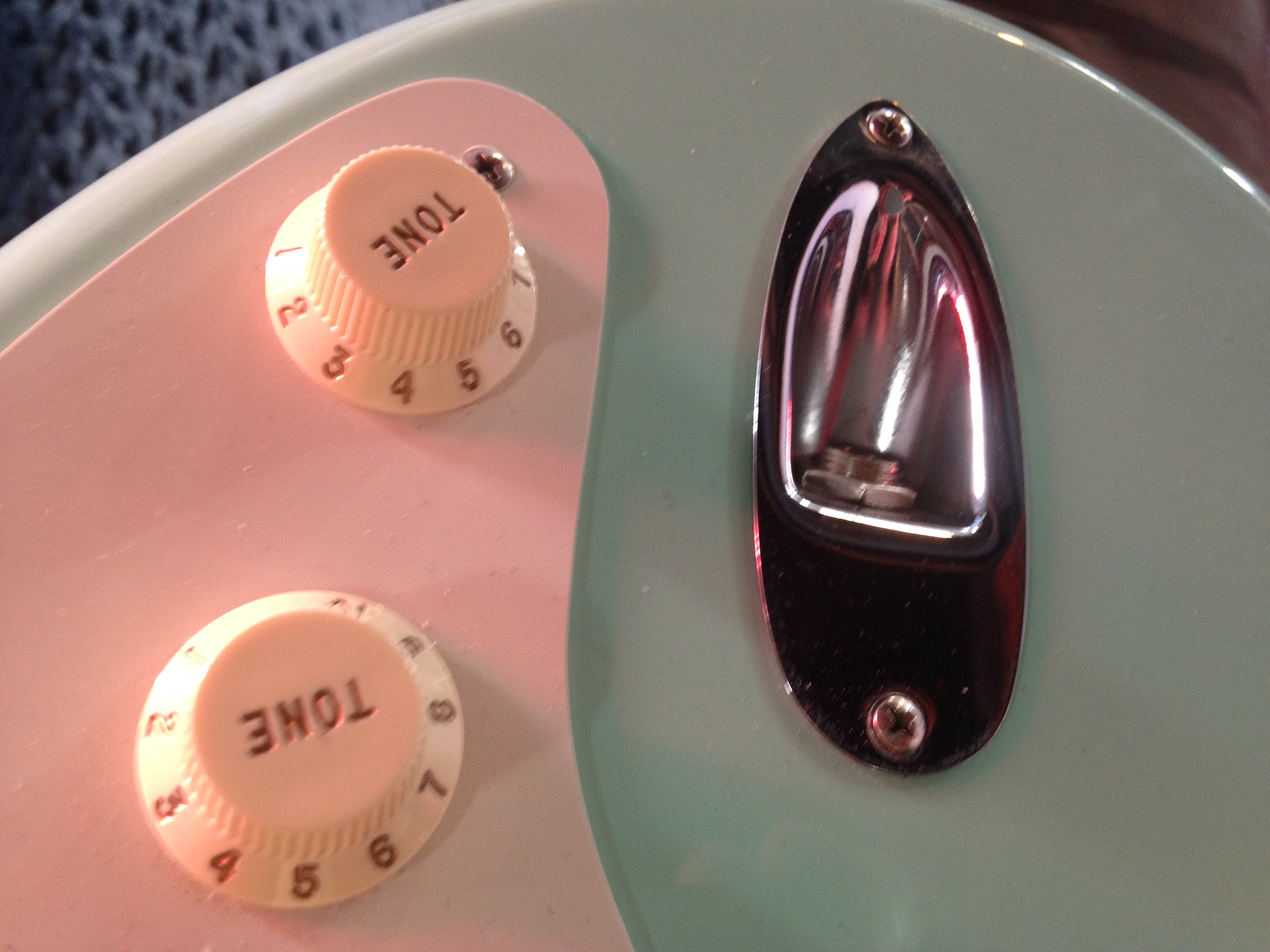 I had a few problems with the jack output, the grip on the plug was flimsy and sometimes I even had sound problems. A couple of euros purchase and I installed a Switchcraft jack socket, the standard of the market. After all, the guitar itself is a very good instrument and needs nothing more than a good amp and player. I convinced a guy in buying a MIM Stratocaster (a Classic 60s this time), and he completely loves it, after years of playing a 4-times more expensive MIA Les Paul. Of course, Fender make these guitars in order to target a less affluent market, so you should expect lower quality parts with respect to their American-made counterparts.
I had a few problems with the jack output, the grip on the plug was flimsy and sometimes I even had sound problems. A couple of euros purchase and I installed a Switchcraft jack socket, the standard of the market. After all, the guitar itself is a very good instrument and needs nothing more than a good amp and player. I convinced a guy in buying a MIM Stratocaster (a Classic 60s this time), and he completely loves it, after years of playing a 4-times more expensive MIA Les Paul. Of course, Fender make these guitars in order to target a less affluent market, so you should expect lower quality parts with respect to their American-made counterparts.
From top to bottom you could think of replacing tuners, nut, scratchplate, pickups (?), tremolo, knobs/switch (?), and jack socket.
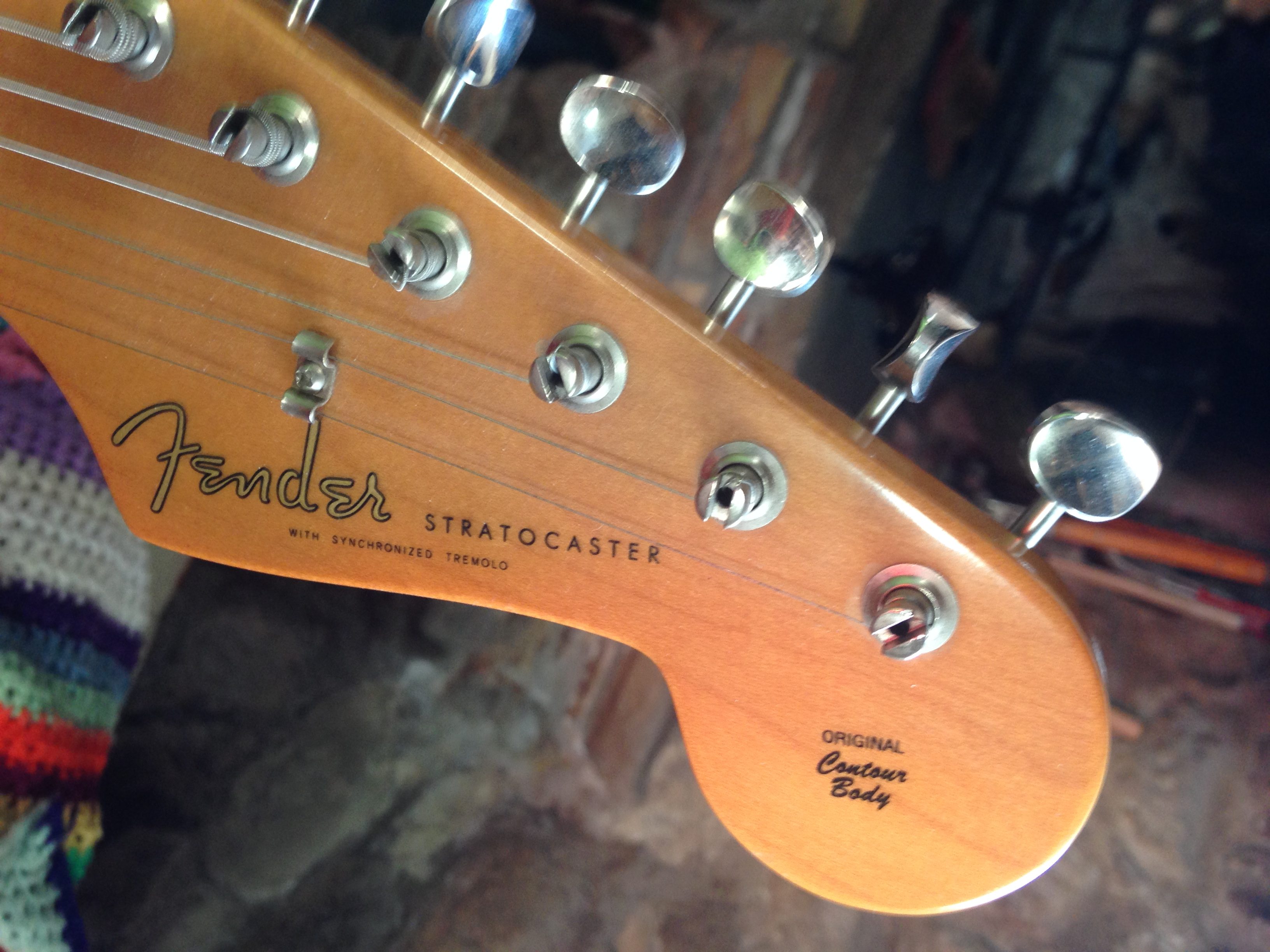 The tuners are cheap Pings, Gotohs, or even better Kluson like the real thing of the 50s, would be great but you must be sure about the right replacement for that guitar, since the holes may vary in size.
The tuners are cheap Pings, Gotohs, or even better Kluson like the real thing of the 50s, would be great but you must be sure about the right replacement for that guitar, since the holes may vary in size.
The nut is made of synthetic bone. You could buy a real bone nut and file it (or have it filed) to proper specs according to the string gauge you use (this model comes with .010s – by the way, I am unable to go away from D’Addario: I experienced tuning and intonation issues with DRs and string breaks with E. Balls). The guitar does have problems in staying in tune after bending some strings (the trem plate goes up while bending), the thinner string tend to go flat after bending and sharp after some soft whammy bar use. Maybe some lubrication at the bridge, nut and string tree would solve the issue – graphite seems not to be enough. Some say a steel block may help, also that properly filed real bone nut or maybe better tuners and/or 4 tremolo springs instead of the stock 3. We’ll see…
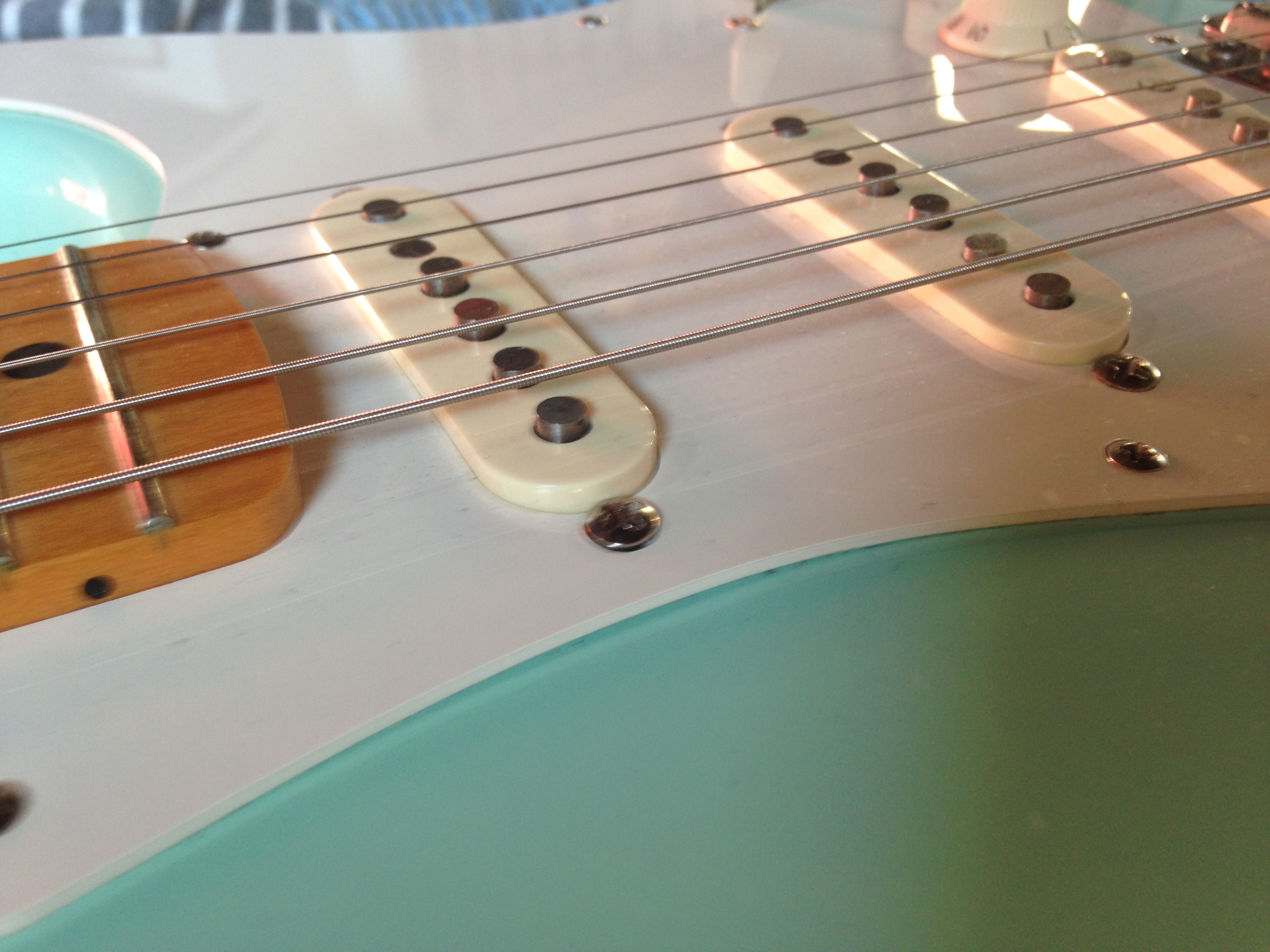 The scratchplate is the 1-ply 8-screw vintage 50s type. It’s a bit flimsy, it gets warped with time and the pickups don’t look firmly placed on it. There are 3-ply 8-screw replacements available but it would change the 50s look. I’d prefer a firmer 1-ply replacement simply made of better plastic (note: the original plastic parts of the 50s came from Italy, top producer of the time; they used to turn yellowish with age, so the pickup covers, knobs, and tremolo arm’s tip in this model are all yellowish so that they seem aged – a bit silly actually). If in the mood, one could think of buying a good quality loaded scratchplate, with pickups, pots and knobs already mounted – maybe one from an American Vintage?). One vintage specific addition would be a metal plate under the scratchplate, originally intended to better isolate the pickups cavity in the Statocaster’s body. No idea if it is worth it….
The scratchplate is the 1-ply 8-screw vintage 50s type. It’s a bit flimsy, it gets warped with time and the pickups don’t look firmly placed on it. There are 3-ply 8-screw replacements available but it would change the 50s look. I’d prefer a firmer 1-ply replacement simply made of better plastic (note: the original plastic parts of the 50s came from Italy, top producer of the time; they used to turn yellowish with age, so the pickup covers, knobs, and tremolo arm’s tip in this model are all yellowish so that they seem aged – a bit silly actually). If in the mood, one could think of buying a good quality loaded scratchplate, with pickups, pots and knobs already mounted – maybe one from an American Vintage?). One vintage specific addition would be a metal plate under the scratchplate, originally intended to better isolate the pickups cavity in the Statocaster’s body. No idea if it is worth it….
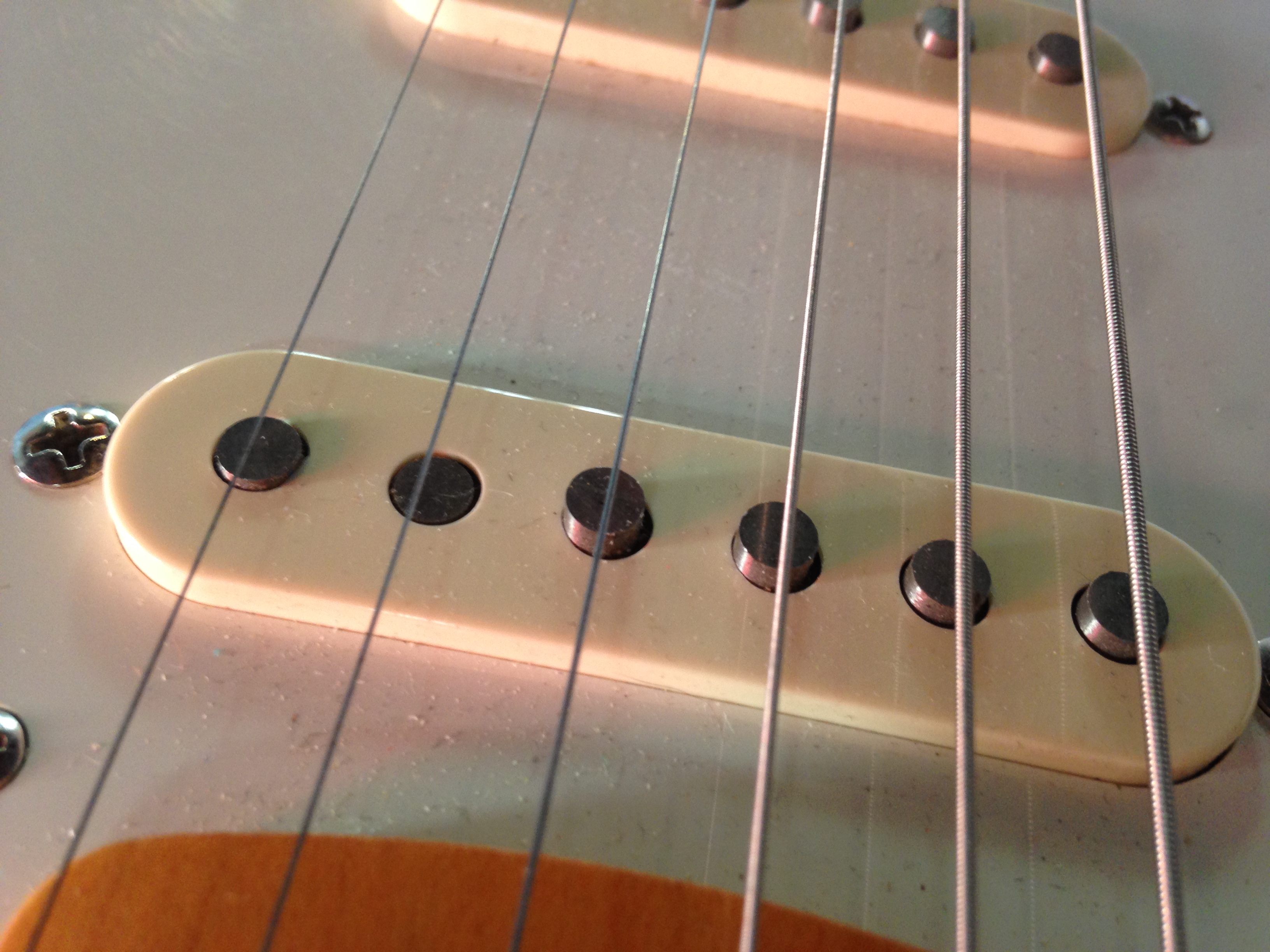 Pickups: here I have several doubts. Far better players than me asked me about those pickups because of the beautiful sound that came out of my guitar. Well, if it is true that the tone is in your fingers, I am really flattered. But the sound of a guitar is mostly coming from the pickups. Good quality pickups are mandatory. These are simple Alnico V pickups assembled in Mexico at Fender according to the 50s specs. The Vintera pickups are more closely time-specific and I figure the American Vintage and Original series are even more so. I am also sure there are both cheaper and more expensive upgrade paths. An experienced artisan can make pickups according to any period-specific specs. Several models are available in the market, from those who fully comply to the 50s specs, to those who have modern features like the hum-canceling ones, but it seems they lose some sparkle from the loss of noise. A good idea would of course be the 50s-spec’d pickups by Fender itself out of a modern Vintera or American Original. As of now, the only annoying thing is that they don’t stay straight up, out of the scratchplate: they are a bit tilted sideways because of the poor material used as spacers around the pickup height adjustment screws.
Pickups: here I have several doubts. Far better players than me asked me about those pickups because of the beautiful sound that came out of my guitar. Well, if it is true that the tone is in your fingers, I am really flattered. But the sound of a guitar is mostly coming from the pickups. Good quality pickups are mandatory. These are simple Alnico V pickups assembled in Mexico at Fender according to the 50s specs. The Vintera pickups are more closely time-specific and I figure the American Vintage and Original series are even more so. I am also sure there are both cheaper and more expensive upgrade paths. An experienced artisan can make pickups according to any period-specific specs. Several models are available in the market, from those who fully comply to the 50s specs, to those who have modern features like the hum-canceling ones, but it seems they lose some sparkle from the loss of noise. A good idea would of course be the 50s-spec’d pickups by Fender itself out of a modern Vintera or American Original. As of now, the only annoying thing is that they don’t stay straight up, out of the scratchplate: they are a bit tilted sideways because of the poor material used as spacers around the pickup height adjustment screws.
I already talked about the tremolo. Maybe a steel block would be good (but I haven’t changed it yet – and still I received compliments for my sound). They say if you change the block, the plate is of lesser quality, so you should replace it, too. In doubt, find the correct Gotoh tremolo assembly or a Fender Pure Vintage (Callhams are the better built, but more expensive) and go for it.
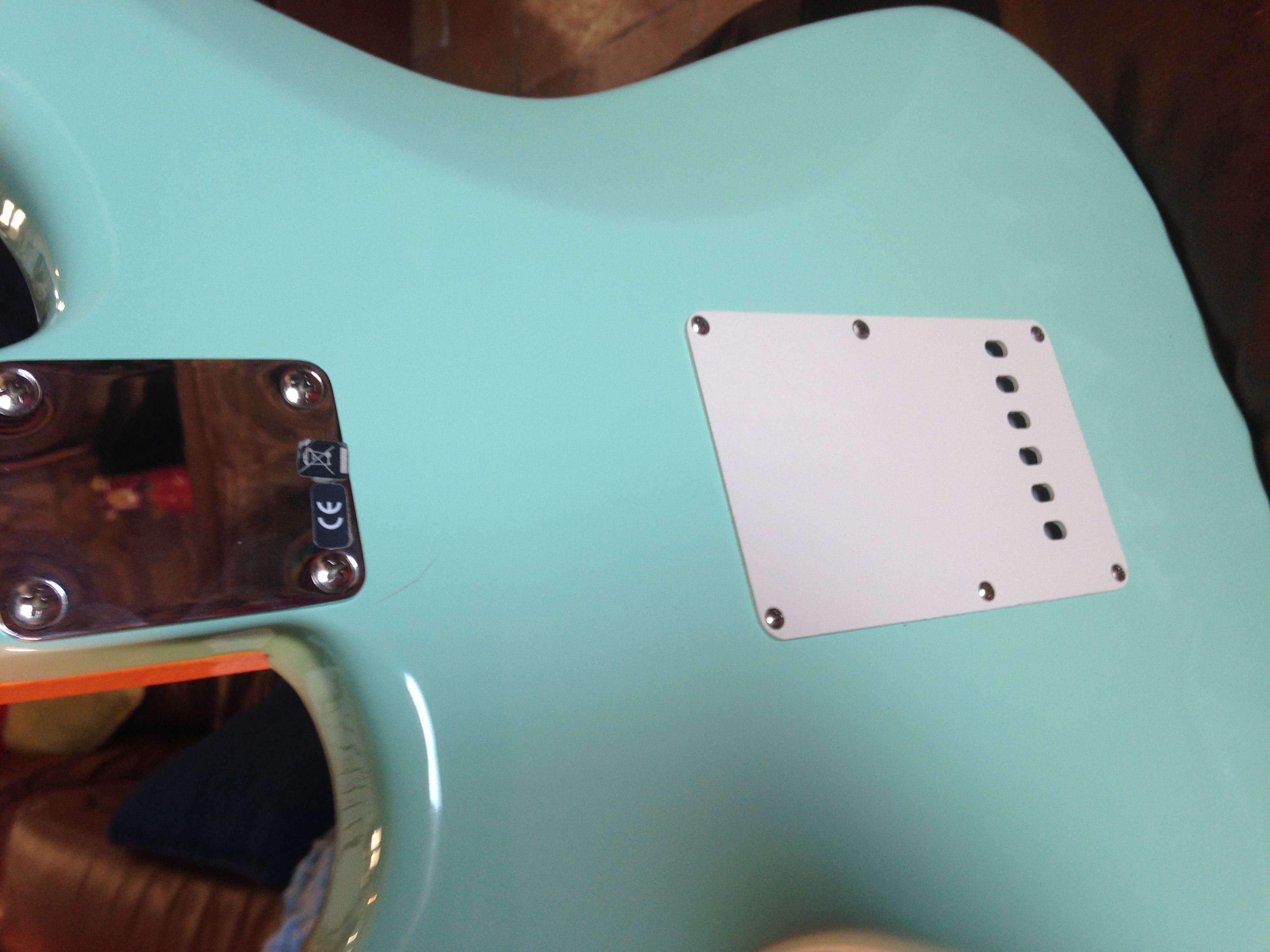 The power and tone controls are said to be GTS, the right standard brand. But I have tried the knobs of other Strats and they felt quite firmer. So one could think of upgrading them when in the mood. There are also simple mods (adding a resistor) that would make the tone pots work more smoothly and precisely. I don’t know about the switch, maybe all electrical parts are worth an upgrade, but as long as everything is working I won’t touch them. I upgraded the jack socket to a Switchcraft only because it caused problems. It is so cheap and easy to replace that I would do it right away, since it seems that sooner or later it will fail.
The power and tone controls are said to be GTS, the right standard brand. But I have tried the knobs of other Strats and they felt quite firmer. So one could think of upgrading them when in the mood. There are also simple mods (adding a resistor) that would make the tone pots work more smoothly and precisely. I don’t know about the switch, maybe all electrical parts are worth an upgrade, but as long as everything is working I won’t touch them. I upgraded the jack socket to a Switchcraft only because it caused problems. It is so cheap and easy to replace that I would do it right away, since it seems that sooner or later it will fail.
I haven’t tried and don’t know much about the new Vintera (Vintage-era) Series. It seems they made the guitars more period-specific, especially by redesigning the pickups for the all different 50s, 60s and 70s. The old Classic Series had very similar pickups throughout the different models. The good news for me is that apparently they were all 50ish, so my axe should not be too far from the Vintera specifics. But Fender claim they did a really thorough work on the new pickups, so I could expect a good improvement on the most sound-sensitive component of a guitar.
Some claim Fender has raised the prices of MIM guitars. I’m not surprised. Reality is: if you really want a great Stratocaster you can build one with the best parts you can afford and to your own specs. It may cost as much as a Vintera or even more. You could ask a luthier to build the wood parts for you. Honest and not famous ones will make you spend much less (especially if you are not in the USA and need the parts shipped from there)! The used market has plenty of choice and you can buy a cheap  Classic Series (even Squiers are great these days!) and upgrade it to Vintera or even American Ultra specs with time. Maybe the selected woods won’t be that good, but as long as
Classic Series (even Squiers are great these days!) and upgrade it to Vintera or even American Ultra specs with time. Maybe the selected woods won’t be that good, but as long as
the neck is fine, the guitar is also fine (you can replace the body with a top quality one and have it painted with nitrocellulose instead of the usual polyurethane). Anyhow, a piece of wood is a piece of wood. Once you’re cool with it, all other stuff can be changed as you please, one step at a time.
As of now, I love my MIM Stratocaster, I like the fact it mimics the way the first ones were made in the 50s. I dreamed about a Stratocaster since I was 15; when the time came I could afford one, I just thought my first should have been the closest possible to the original project, just to honor Leo Fender’s legacy while realizing my dream. I am sure a new Vintera Stratocaster has something more than my Classic 50s. Nothing I couldn’t upgrade to in the future if I wanted to. If they did a better job with painting, that could maybe be the biggest difference (and it is the biggest difference to the American ones). All other stuff can be replaced (well, you can even repaint it). Maybe one day I’ll got Kluson tuners, bone nut and a Gotoh tremolo for it. But as of now I really enjoy playing my Strat as it is.